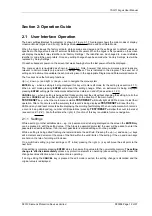
7SG11 Argus User Manual
©2013 Siemens Protection Devices Limited
P20006 Page 24 of 37
reverse lead
-57.5
-67.5
reverse lead
-152.5 -162.5
reverse lag
117.5
127.5
reverse lag
22.5
32.5
forward lag
-82.5
-92.5
forward lag
-172.5 -182.5
forward lead
82.5
92.5
forward lead
-7.5
2.5
reverse lead
-87.5
-97.5
reverse lead
-177.5 -187.5
0
reverse lag
87.5
97.5
-90
reverse lag
-2.5
7.5
forward lag
-97.5 -107.5
forward lead
67.5
77.5
reverse lead
-102.5 -112.5
E/F
-15
reverse lag
72.5
82.5
General Tests
Voltage sensitivity can be tested if required by injecting current of twice setting at the Characteristic Angle. The
voltage should then be increased from zero until operation of the directional element is indicated. Operation
should occur at less than 2V for phase fault and less than 3.3V for earth fault.
In Argus relays where the two-out-of-three gate function is available and is enabled then this feature can be
checked. Provide a reference voltage V
BC
and inject current at the characteristic angle into the A pole and check
that no ‘FWD’ operation occurs. Repeat injecting ‘FWD’ operate currents into two poles simultaneously and the
Argus should operate. (This test can be carried out as shown in Figure 4-5. A single phase voltage is applied
across two inputs with the third in reverse, and a single phase current at characteristic angle is injected through all
three poles in series,. This applies one pole ‘FWD’ and the other two poles ‘REV’; reverse the current direction to
give two poles ‘FWD’ and one pole ‘REV’.
Further tests may be required to check that the directional control settings have been correctly applied where
these are complex. Similarly, if different threshold and delay settings have been applied for forward and reverse
operation then these should be tested. Such additional tests should be specified according to the particular
requirements of the scheme.
4.2.4 Auto Reclose Sequences
These tests apply to Argus 4 and Argus 6 relays only
The Auto Reclose sequences to be applied in-service should be set up and proved for each of the fault types. As
detailed in section 4.1.1 it is suggested that a portable Personal Computer (PC), with Reydisp Evolution installed,
be connected to the Argus via an RS232 to Fibre Optic Modem and Fibre optic cables. This will greatly facilitate
the testing and documentation of the results of the various tests applied to the Scheme.
Reydisp Evolution can display the complete chronological event record generated by a full multi-shot Auto
Reclose sequence for post test analysis (it is often difficult on site to keep track of protection and circuit breaker
operations during a sequence test). The analysis function provided on the event record display enables the user
to make time difference comparisons between two events. This allows, for example, accurate measurement of the
Reclose delay (Dead time), or the Reclaim delay, without external equipment. The following information can be
easily measured from a single Sequence event record: -
Instantaneous Protection element operate times
Circuit Breaker first Trip time
Protection Starter element reset time
Reclose (Dead Time) delay
Circuit Breaker Close time
Delayed Protection operate times
Subsequent Circuit Breaker Trip and Close times
Subsequent Reclose delays
Reclaim delay
Overall sequence time
Status Interlock timing
Also the Waveform Record display for each trip enables time measurements to be made between the analogue
waveforms and the digital (binary) traces of the Status inputs and output relays. Measurement of the relative
timing of the a.c. current waveforms and the Circuit Breaker Status contacts provides valuable data on the
condition of the Circuit Breaker operate times
In addition the Instruments provided by the Argus can be continuously monitored via Reydisp during a test
sequence providing information on the state of the Argus and Circuit Breaker during a test sequence.
















































